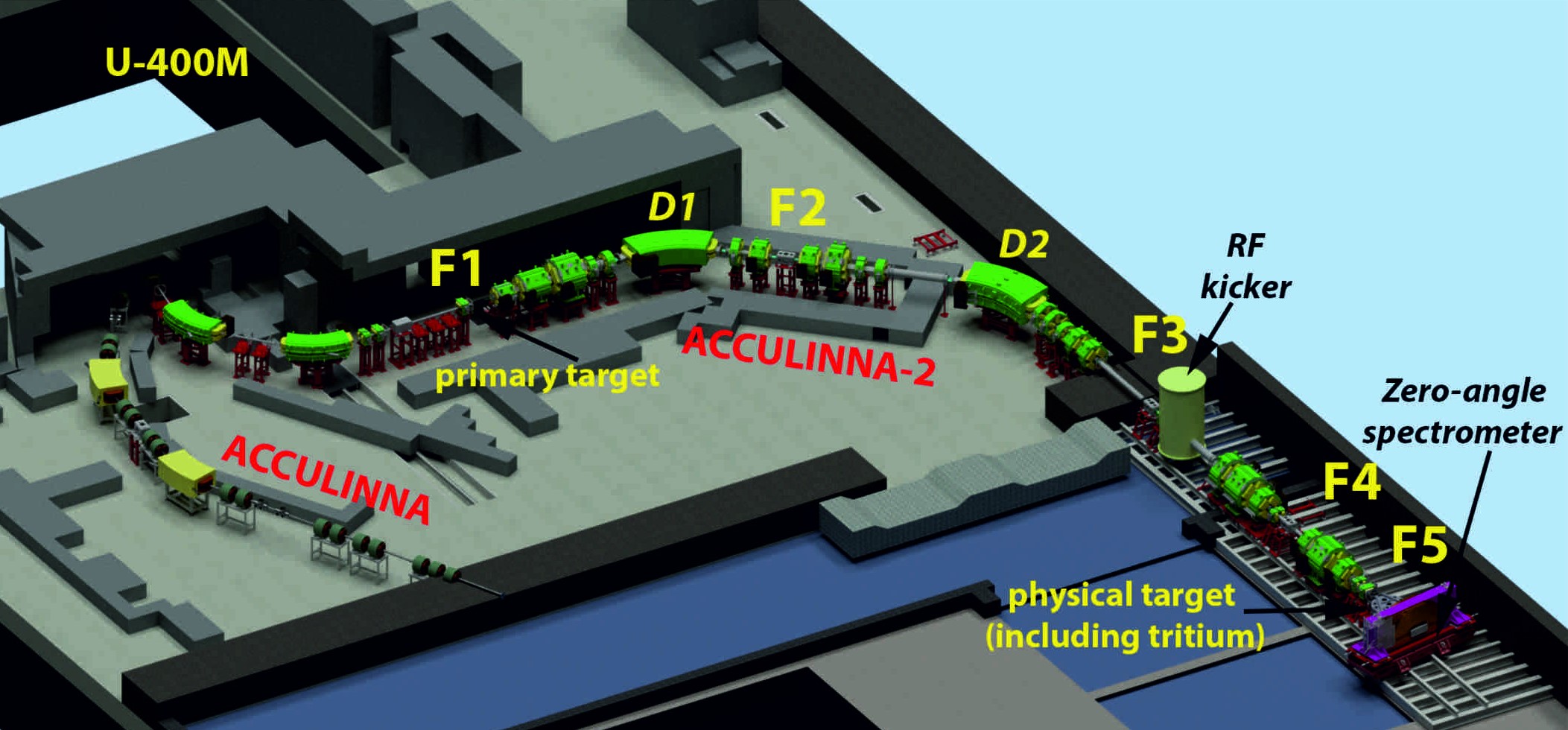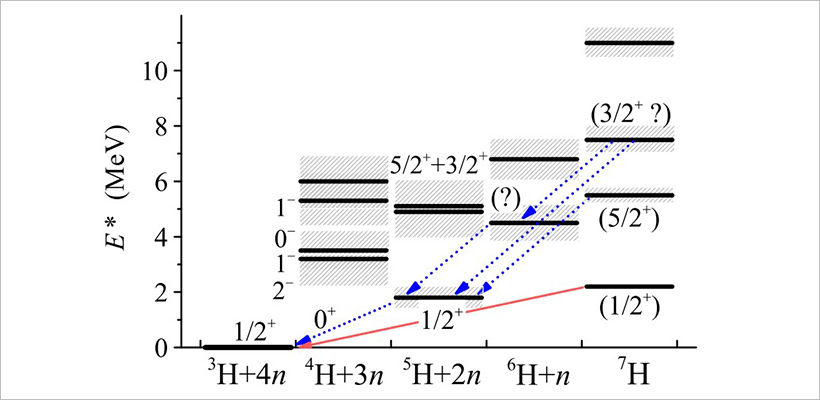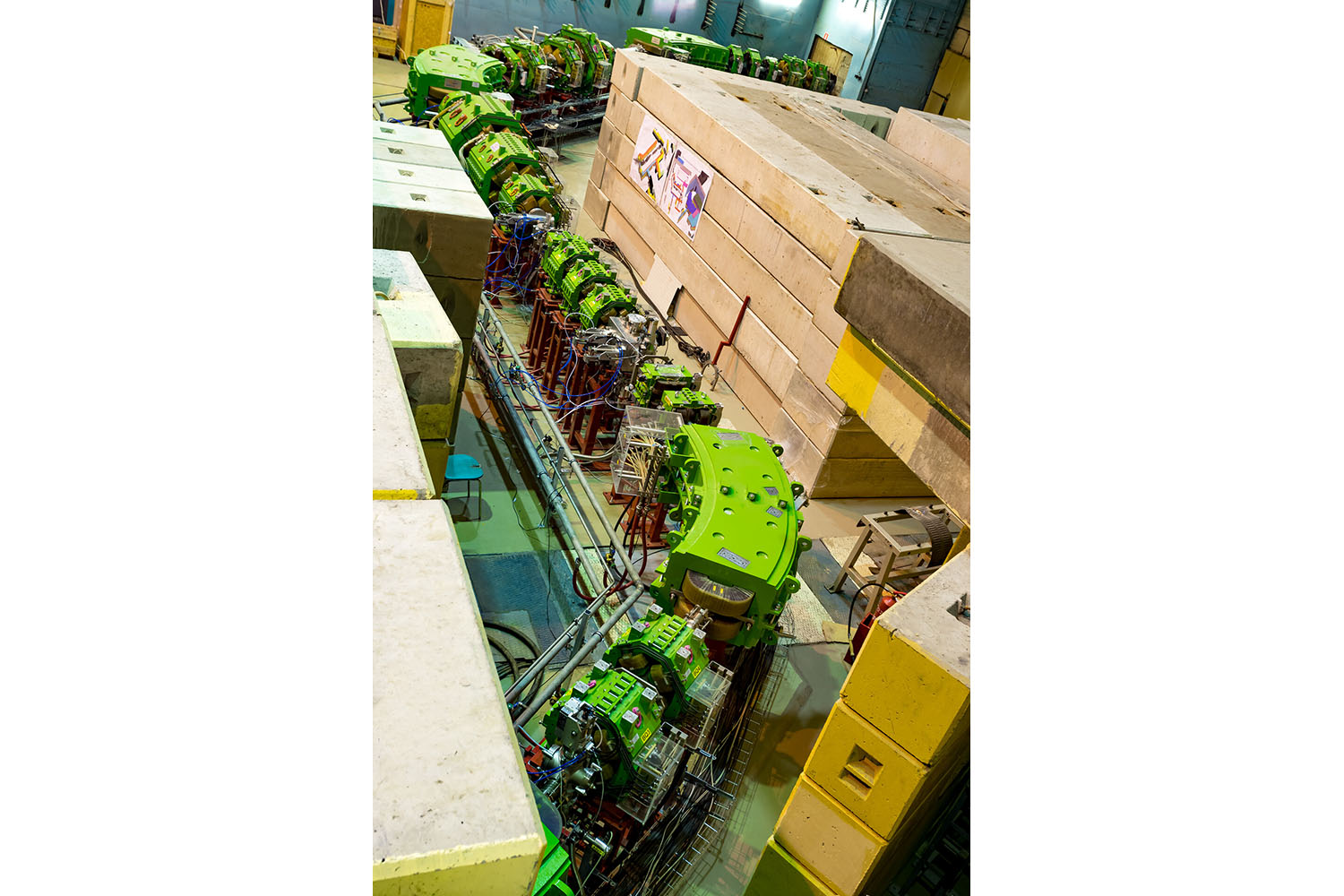New nuclear decay mode detected at FLNR JINR in studying superheavy hydrogen systems
News, 22 September 2023
On 22 September, the second day of the 134th session of the JINR Scientific Council, JINR Prizes for 2022 were awarded. A research team from the Flerov Laboratory of Nuclear Reactions was among the prize winners: Andrey Bezbakh, Leonid Grigorenko, Alexander Gorshkov, Sergey Krupko, Ivan Muzalevskii, Evgeny Nikolskii, Gurgen Ter-Akopian, Andrey Fomichev, Vratislav Chudoba, and Pavel Sharov. A series of publications titled “New data on the spectra of superheavy isotopes of hydrogen 7H, 6H and the detection of spontaneous decay mode with the emission of four neutrons” was recognized with the Second JINR Prize in the category “Experimental Research Work”.
The researchers from JINR’s Flerov Laboratory of Nuclear Reactions carried out first experiments at the ACCULINNA-2 fragment separator that resulted in the detection of the heaviest hydrogen isotopes 6Н and 7Н, thereby resolving one of the key issues that has long been posing challenges to experimentalists. New data were obtained on the spectra of the superheavy isotopes of hydrogen 6H and 7H, and a new type of spontaneous nuclear decay with a simultaneous emission of four neutrons was detected. The researchers continue focusing their efforts on advancing the experimental equipment and on preparing for new experiments. In August 2023, the team’s article devoted to reference reactions in synthesizing superheavy hydrogen systems was published.
 Andrey Bezbakh, head of the research group in the Flerov Laboratory of Nuclear Reactions, has been instrumental in the implementation of novel precision detector systems in the ACCULINNA-2 fragment separator (operating neutron wall).
Andrey Bezbakh, head of the research group in the Flerov Laboratory of Nuclear Reactions, has been instrumental in the implementation of novel precision detector systems in the ACCULINNA-2 fragment separator (operating neutron wall).
To date only seven hydrogen isotopes are known, of these three existing in nature: stable protium 1H (most widely spread) and deuterium 2H, as well as radioactive tritium 3H with a half-life of ~ 12 years. Other isotopes of hydrogen, 4-7Н, were synthesized in labs: these are mainly unstable nuclei with the lifetimes of 10-22 –10-24 seconds. “Hydrogen-6 and hydrogen-7 have been studied for over fourty years in various research centers around the world. However, these nuclei cannot be directly observed owing to their extremely short lifetimes. It is only their decay products that can be registered, which points to the resonant states of these nuclei,” the head of the detector systems group in FLNR JINR Andrey Bezbakh said. He noted that the FLNR research team pushed the limits of understanding the properties of the 7Н nucleus in experiments on the production of superheavy hydrogen systems carried out in 2018–2020 and analyzed by the year 2022.
The investigation was aimed at studying the light exotic nuclei of hydrogen-6 and hydrogen-7, which is essential for understanding the properties of other isotopes. “Using available radiactive beams, we have an opportunity to define the properties of light exotic nuclei within our reach, verify these properties, and try to interpret them. We can apply the accumulated knowledge of relatively simple systems to the region of more exotic nuclei,” Andrey Bezbakh commented.
The scientist said that for over 40 years the superheavy isotopes of hydrogen 7Н and 6Н have puzzled nuclear physics experimentalists and aroused increased interest for a variety of reasons. These are the most neutron-rich systems conceivable, with one proton and 6–7 neutrons, respectively. The 7Н has a closed p3/2 neutron subshell, so the orbital cannot be further “filled” with more nucleons, thus its detection could open up new possibilities for shell dynamics investigations under conditions of severe proton deficit. Owing to the subshell closure in 7H, the existence of heavier, more long-lived isotopes of hydrogen is highly unlikely. This is beyond current physics concepts and theoretical predictions,” the scientist said.
Moreover, we have every reason to believe that the 7Н ground state decay exhibits unique dynamics – a so-called “true” five-body decay 7Н → 3Н + 4n, suggesting an almost simultaneous four-neutron emission. Such decay mechanism implies notably long lifetimes and may lead to a new radioactive decay mode –4n radioactivity. Long 6Н–7Н lifetimes refer to fractions of a second sufficient for the registration of isotopes.
Experiments at the ACCULINNA-2 fragment separator of the U-400М cyclotron in the Flerov Laboratory of Nuclear Reactions at JINR provided first experimental evidence for such type of hydrogen-7 decay.Researchers at other leading institutions, such as RIKEN (Japan), GANIL (France), and GSI (Germany), have repeatedly attempted to study the properties of the ground state of the hydrogen-7 nucleus. These efforts, however, did not bear fruit and did not lead to any quantitative conclusions either. At an experimental resolution of ~ 2 MeV and higher, all the structures observed earlier in the 7Н spectrum had to merge into a continuous spectrum, and the weakly populated 7Н ground state could “drown” in background and first excited state events. Research at ACCULINNA-2 allowed the scientists to attain the best experimental resolution to date: for the ground state at Е ~ 2.2 MeV, ΔE amounted to ~ 1 MeV (FWHM, full width at half the height – the difference between the maximum and minimum of the argument of a function taken at a level half of its maximum).
 Fig. 1. Schematic arragement of ACCULINNA-2 fragment separator in the U-400M accelerator hall.
Fig. 1. Schematic arragement of ACCULINNA-2 fragment separator in the U-400M accelerator hall.
The ACCULINNA-2 fragment separator at the heavy-ion U-400M accelerator was commissioned in the Flerov Laboratory of Nuclear Reactions in 2017. “The commissioning of ACCULINNA-2 made the pursuit of the 7Н isotope more feasible: the intensity of about 105 pps was attained for the 26-AMeV 8He beam, thereby approaching world records,” Andrey Bezbakh said.
In 2018 first physics experiments with the radioactive beams 6Не, 8Не, 9Li, 10Be, and 27S were launched. Further development of experimental techniques had continued with a view to increasing luminosity and energy resolution of experiments. A series of papers dedicated to this topic was recognized with the Second JINR Prize for 2020.
In addition, the development of theoretical approaches had continued for the study of rare decay channels with the emission of four neutrons [1]. The researchers themselves speak about the obtained results.
In 2018 and 2019, a year apart, two experiments were conducted at ACCULINNA-2. The 2Н(8Не,3Не)7Н reaction was studied at the 8Не energy of 26 MeV/nucleon. In the first experiment [2], 3Не recoil nuclei flew out of the cryogenic deuterium gas target at the energy of 9–25 MeV in the angular range of 8°–26° with respect to the trajectory of the 8Не projectile. They were detected by two silicon detector telescopes in coincidence with 3Н nuclei—expected 7Н decay products—emitted in the forward direction. A relatively narrow (a width of 2.0(5) MeV) excited state of 7Н was detected for the first time at the energy ЕT = 6.5(5) MeV above the 3Н + 4n decay threshold. A group of five events within the energy range 0.5 < ЕT < 2.5 MeV was also registered in the 7Н energy spectrum, which was considered as candidates for the 7Н ground state with ЕT = 1.8(5) MeV above the 3Н + 4n decay threshold. All the observed events of the presumed 7Н ground state were registered within the center-of-mass angular range 17°–27° for the 2Н(8Не,3Не)7Н reaction, corresponding to the expected position of the second diffraction maximum for the ground state population cross section.
Drawing on experience gained in [2], the measurement technique was improved in the experiment [3] carried out in April 2019. To accumulate data about the population of the 7Н ground state resonance within the angular range corresponding to the first diffraction maximum of the 2Н(8Не,3Не)7Н reaction, the 3Не emission angle limit was reduced to 6°. The number of telescopes for registering 3Не was doubled. Moreover, the neutron wall, located at a 2-m distance from the target, registered neutrons, which reinfored the conclusion about the identification of 7Н in the decay channels. An additional calibration measurement was conducted in the experiment [3]: the 9Li energy spectrum was obtained using the reference reaction 2Н(10Bе,3Не)9Li at the energy Е(10Ве) = 44 MeV/nucleon. The known 9Li levels allowed an independent determination of the experimental resolution and the required calibration of the entire setup. The experimental results [3] were in full agreement with those in [2]. Experimental statistics was increased four-fold. In the low-energy part of the spectrum, five events were triple 3He-3H-n coincidences detected within the regions of the observed peaks. In the missing-mass spectrum, 11 events were detected as candidates to represent the 7Н ground state at ЕT = 2.2(5) MeV. These events were broken down into two groups with regard to the center-of-mass reaction angles 5°–10° and 17°–27° and the expected first and second diffraction maxima of the ground state. Two narrow states were detected at ЕT = 5.5 and 7.5 MeV, which could be interpreted as a doublet 5/2+-3/2+. In experiment [2], they appeared as a single 6.5-MeV structure. The data [2, 3] point to a resonance state at ЕT = 11 MeV.
Thereto the technique employed in the experiment [3] allowed for the study of the 6Н spectrum populated in the 2Н(8Не,4Не)6Н reaction[4]. Similarly to 7Н, the detection of high-energy tritons in coincidence with 4He was assumed to serve an indicator of one or several sequential 6Н decays. The calibration measurement in the 2Н(10Bе,4Не)8Li reaction confirmed the efficiency of the used method for identifying 8Li and studying the mechanism of the (d,α) reaction. The missing mass spectrum of 6Н was reconstructed from low-energy 4He recoils detected in coincidence with tritons and neutrons. Experiment simulations and data showed that the energy resolution in the missing mass spectrum was better than 2MeV. Record-breaking statistics for the 6Н system was collected in the experiment [4]: over 4,000 double 4He-3H coincidences and about 130 triple 4He-3H-n coincidences. In the reconstructed 6Н spectrum, an important finding was the absence of possible states within the energy range ЕТ< 3.5 MeV above the 3H+3n decay threshold. The result disagrees with data obtained in the pioneering research [Aleksandrov et al., “Observation of nonstable heavy hydrogen isotope 6Н in the reaction 7Li(7Li, 8B)”. Yad. Fiz., 39:513, 1984.], where the observation of the 6Н resonance state at the energy ЕT = 2.7(4) MeV was for the first time declared (the formation of the bump is accounted for by[4] an order of magnitude higher cross section of the 7Li(7Li, 9B*)5H reaction populating the 5Н ground state). The correlation analysis [4], with due regard for triple 4He-3H-n coincidences, helped define two possible states of the 6Н isotope at ЕТ ~ 4.5 (ground state) and 6.8 MeV.
 Fig. 2.The scheme of levels and possible decay channels of 6,7Н. The red arrow indicates an open 4n channel.
Fig. 2.The scheme of levels and possible decay channels of 6,7Н. The red arrow indicates an open 4n channel.
Some general conclusions can be drawn from the research aimed at searching for the low-laying 7Н states in the 2Н(8Не,3Не)7Н reaction and those of 6Н in the 2Н(8Не,4Не)6Н reaction:
- The position of the 7Н ground state (presumably 1/2+) is established as 2.2(5) MeV above the 3Н+4n threshold with the width defined by the experimental resolution of ~1 MeV.
- A doublet is observed (presumably 5/2+-3/2+) with respect to the narrow states at 5.5(3) and 7.5(3) MeV. The excited state is observed at 6.5 MeV (centroid of the doublet) in experiment [2] and can be interpreted as the unresolved 5/2+-3/2+ doublet.
- The extreme peripheral character of interaction in the 8He+d channel, also confirmed by the angular distributions dσ/dΩ
c. m. , account for the extremely low cross section (~ 25 µb/sr) observed for the 7Н ground state population. This reflects excessive amorphousness and a “fragile” nature of the neutron-rich system, unable to survive in central collisions. - The obtained results account for unsuccessful efforts made earlier in search of the 7Н ground state. At an experimental resolution of ~ 2 MeV or lower, all the structures previously observed in the 7Н spectrum had to merge into one continuous spectrum, and the weakly populated 7Н ground state could “drown” in background and first excited state events.
- The previously claimed 6Н ground state at ~ 2.6‒2.9 MeV above the 3Н+3n threshold was not observed in our study of the 2Н(8Не,4Не)6Н reaction with a limit for the cross section dσ/dΩ с.m.< 5 µb/sr.
- In the 6Н spectrum, a broad structure was observed with the energy of 6.8 MeV above the 3Н+3n threshold and the cross section dσ/dΩc. m. ~ 190 µb/sr, typical for the direct deuteron transfer reaction. This structure can be interpreted as one or several resonance states with the lower energy limit ЕT = 4.5 MeV for the ground state.
- The scheme of levels and decays of the “superheavy” hydrogen isotopes 7Н and 6Н (Fig.2) obtained in the experiments [2–4] allows us to claim that the decay of the 7H ground state may be accompanied by a simultaneous emission of four neutrons (a “true” five-body decay 3Н+4n). First substantial evidence was provided for the existence of this type of nuclear decay mode.
- First experiments at the new ACCULINNA-2 fragment separator resulted in the detection of the 6Н and 7Н isotopes, thereby resolving one of the key issues that had long been posing challenges to experimentalists, and advanced understanding of a novel mode of spontaneous nuclear decay accompanied by a simultaneous emission of four neutrons. The core issues of the work, proceeding in stages, were repeatedly reported at international conferences on nuclear physics, as well as at FLNR and JINR seminars.
The research team keeps on analyzing the collected experimental data and is preparing for new experiments that will resume after the U-400M cyclotron is back in business following the upgrade. In particular, FLNR staff members are engaged in the creation of a specialized neutron wall (Bezbakh et al., “Detector array for the 7H nucleus multi-neutron decay study”, preprint, 2022). “The quality of experiment can be significantly enhanced by registering neutrons emitted in the hydrogen-7 decay. In our previous experiment, we used roughly 40 neutron detectors and are planning to increase their number up to 150, thus boosting the luminosity of experiments many fold. Now we are working at electronics, the neutron wall data aquisition system, gradually preparing it for commissioning. “Packing electronics, allocating the detector array and simulating experiment – this is no easy task,” Andrey Bezbakh commented.
Moreover, Andrey said that in August this year FLNR team, which was awarded the JINR Prize, issued an article about reference reactions in synthesizing superheavy hydrogen systems (Nikolsky et al., “Study of proton and deuteron pickup reactions (d,3He), (d,4He) with 8He and 10Be radioactive beams at ACCULINNA-2 fragment separator”, NIM-B, 2023).
The team will continue focusing efforts on the implementation of the ambitious FLNR JINR research programme, including that aimed at studying the 7Н exotic nuclei.
List of publications:
- P.G. Sharov, L.V. Grigorenko, A. Ismailova, M.V. Zhukov, “Pauli-principle driven correlations in four-neutron nuclear decays”, JETP Letters 110 (2019) 5-14 [Письма в ЖЭТФ 110 (2019) 7-8; arXiv:1808.00513].
- A.A. Bezbakh, V. Chudoba, A.V. Gorshkov, S.A. Krupko, S.G. Belogurov, D. Biare, A.S. Fomichev, E.M. Gazeeva, L.V. Grigorenko, G.Kaminski, O. Kiselev, D.A. Kostyleva, I. Mukha, I.A. Muzalevskii, E.Yu. Nikolskii, Yu.L. Parfenova, A.M. Quynh, A. Serikov, S.I. Sidorchuk, P.G. Sharov, R.S. Slepnev, S.V. Stepantsov, A. Swiercz, P. Szymkiewicz, G.M. Ter-Akopian, R. Wolski, B. Zalewski, M.V. Zhukov, “Evidence for the first excited state of 7H”, Physical Review Letters 124 (2020) 022502 [arXiv:1906.07818].
- I.A. Muzalevskii, A.A. Bezbakh, E.Yu. Nikolskii, V. Chudoba, S.A. Krupko, S.G. Belogurov, D. Biare, A.S. Fomichev, E.M. Gazeeva, A.V. Gorshkov, L.V. Grigorenko, G. Kaminski, O. Kiselev, D.A. Kostyleva, M.Yu. Kozlov, B. Mauyey, I. Mukha, Yu.L. Parfenova, W. Piatek, A.M. Quynh, V.N. Schetinin, A. Serikov, S.I. Sidorchuk, P.G. Sharov, N.B. Shulgina, R.S. Slepnev, S.V. Stepantsov, A. Swiercz, P. Szymkiewicz, G.M. Ter-Akopian, R. Wolski, B. Zalewski, M.V. Zhukov, “Resonant states in 7H: Experimental studies of the 2H(8He,3He) reaction”, Physical Review C 103 (2021) 044313 [arXiv: 2010.09655].
- E.Yu. Nikolskii, I.A. Muzalevskii, A.A. Bezbakh, V. Chudoba, S.A. Krupko, S.G. Belogurov, D. Biare, A.S. Fomichev, E.M. Gazeeva, A.V. Gorshkov, L.V. Grigorenko, G. Kaminski, O. Kiselev, D.A. Kostyleva, M.Yu. Kozlov, B. Mauyey, I. Mukha, Yu.L. Parfenova, W. Piatek, A.M. Quynh, V.N. Schetinin, A. Serikov, S.I. Sidorchuk, P.G. Sharov, N.B. Shulgina, R.S. Slepnev, S.V. Stepantsov, A. Swiercz, P. Szymkiewicz, G.M. Ter-Akopian, R. Wolski, B. Zalewski, M.V. Zhukov, “6H states studied in the 2H(8He,4He) reaction and evidence of an extremely correlated character of the 5H ground state”, Physical Review C 105 (2022) 064605 [arXiv:2105.04435].
